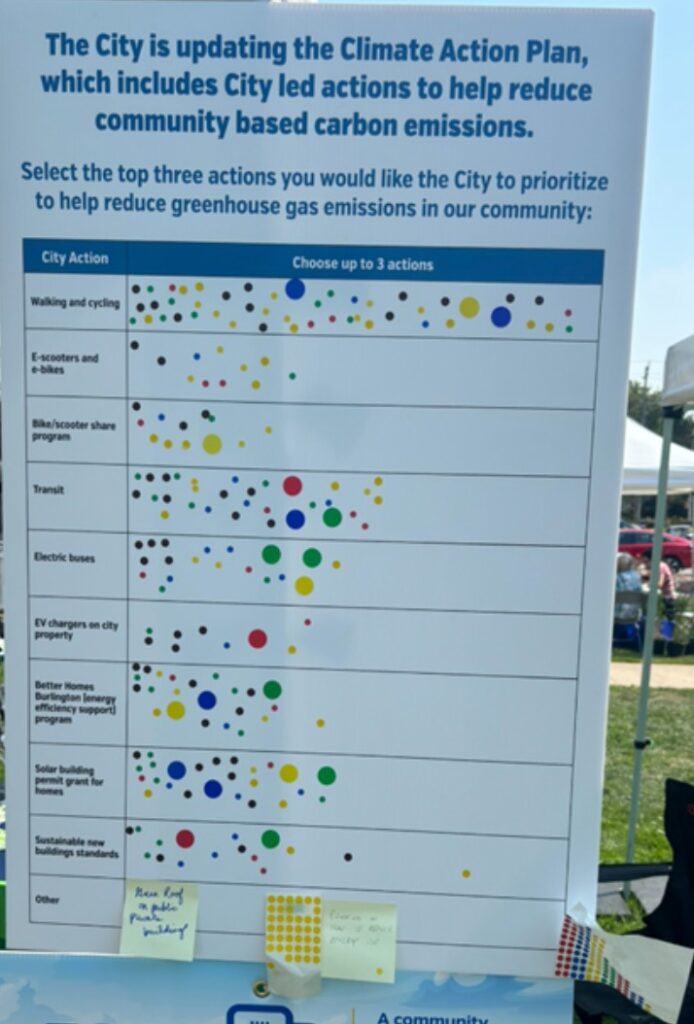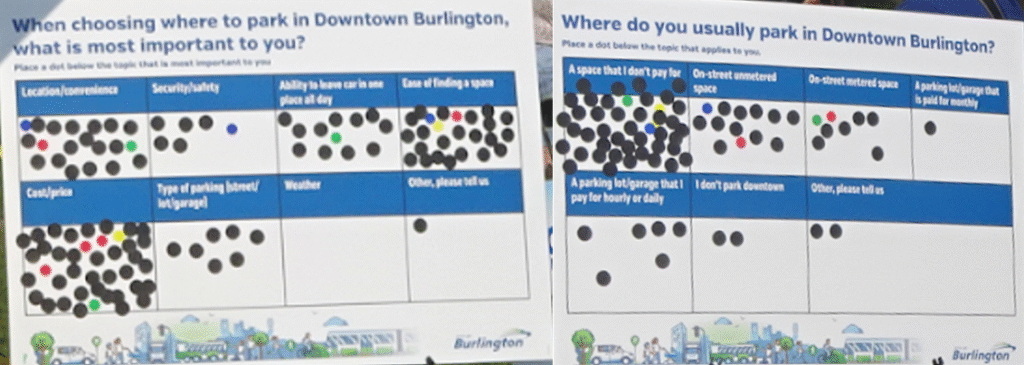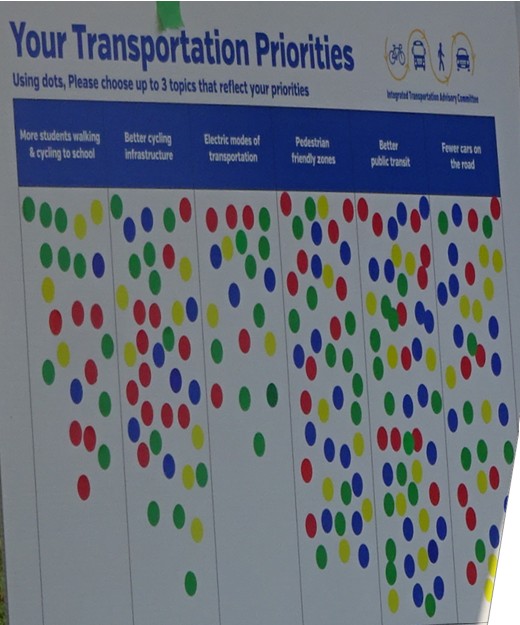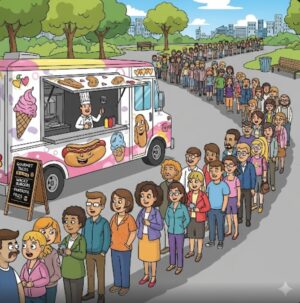Please complete the Focus Burlington Budget survey linked at the bottom of this post.
The annual, City of Burlington, Food for Feedback event is back. Visit Central Park on September 13th, 2025 from 12 – 4 p.m. to participate.
Through a Freedom of Information request, we learned that the city paid $47,657.37 for food at last year’s event (2024). Other costs, such as staff time, tent rentals, cleanup, etc., are not included in this figure. As a comparison, the city grant to the Sound of Music Festival (SOM) is $150,000, but the city turns around and bills SOM for park rental, permits, engineering costs and reports, any road closures (parade), and other items, including WiFi. SOM runs for a weekend, and Food for Feedback runs for four hours.
In terms of the cost to taxpayers, Food for Feedback and Sound of Music are similar.
As a resident, the Food for Feedback event is an interesting way to learn about all the initiatives the city is working on.
What does the city learn from the event?
Agricultural Action Plan

“The city is creating an Agricultural Action Plan to support the economic growth of Burlington’s agricultural sector.”
The BURLINGTON AGRICULTURAL & RURAL AFFAIRS COMMITTEE (BARAAC) has a budget of $1,000.

You can learn a bit more about this committee by clicking here:
Here’s a quick summary of the feedback: Farmers’ Markets, more trees, corn maze, farm camps, equine events, lower prices for food, fall harvest events, and a partnership with food banks.
Traffic and homelessness are raised as concerns; the note “NO MORE TRAFFIC HELP!” says a lot.
This note: “I don’t like to see pigs. I want to see rabbits” speaks volumes about the value of spending well over $50,000 to host this event.
Climate Action Plan

“The City is updating the Climate Action Plan, which includes City led actions to help reduce community based carbon emissions”.
“Select the top three actions you would like the City to prioritize to help reduce greenhouse gas emissions in our community.”
The size of the dots has no meaning, and the colour has no meaning. You can see random dot sheets at the bottom of the picture.
How valuable is this feedback? Unless you’re living in a cave, coincidentally a very low-carbon emissions existence, you have heard about climate change.
The title states “City led actions to help reduce community based carbon emissions”. Community – I think that means us. Should municipal tax dollars be spent leading us to a lower-carbon future? Every time a car stops at a red light, the car has to accelerate when the light turns green. Constantly accelerating and decelerating causes far more carbon emissions than driving at a constant speed.
Speed bumps also contribute to carbon and other emissions.
A city-controlled action, improving traffic flow, is not on the poster for us to select, but a city-led action for residents to undertake, like cycling, is. Why is that?
Downtown Parking

Not surprisingly, “A space that I don’t pay for” and “cost/price” are the winners.
Without spending any money, we asked Google: “What are the most important things people look for in a downtown parking spot?”
Google: “When looking for a “parking near me” option, consider factors like safety, distance to your destination, and parking costs.”
Engagement or telling us how to live?

Take a look at the options on “Your Transportation Priorities”
“More students walking & cycling to school”
“Better cycling infrastructure”
“Electric modes of transportation”
“Pedestrian friendly zones”
“Better public transit”
“Fewer cars on the road”
Has the city admitted that our future is gridlock? Transportation choices will be limited to walking, cycling and public transit. What happens if your employer in Burlington goes bankrupt? In order to find an equivalent job, you need to commute to Cambridge. No problem, Google Maps estimates your travel time, on public transit, at 2.5 hours each way. As residents, do we deserve to have freedom of choice as to where we work and how we commute, or are we just sheep being led by our shepherds?
It’s fair to say many Burlington residents prefer driving their own cars because so many of us have cars. How valid is this input when choices such as “wider roads”, “traffic flow improvements”, “better service roads beside the QEW”, etc., are not even options for people to select? I don’t know how individuals will vote, but the city, by excluding these choices altogether, is not fully engaging with residents.
Does sticking dots on a poster provide valid feedback?
Feedback like this is referred to as dotmocracy. There are known problems with dotmocracy
- Anyone can walk up, take a sticker from the supply on the chart and start adding dots.
- There is no residency requirement. Should people providing feedback on Burlington live or own a business in Burlington?
- There is no age requirement. Comments such as “I don’t like to see pigs. I want to see rabbits” may have come from a younger person or someone who likes rabbits.
- There is no accountability. Someone who lives downtown and likes to use the free EV chargers can put as many dots as they want for that item, skewing the results in their favour.
- When people are adding dots, they may be influenced by the other dots.
- The cost, in terms of time, to count the dots, especially on busy boards, is overwhelming. Someone has to peel off the overlapping dots. If the city doesn’t count the dots, how do they know what the feedback is when opposing ideas both have a large number of dots?
Sherry Arnstein’s “A Ladder of Citizen Participation” (1969) was published in 1969.
Arnstein describes three broad categories of citizen power.
- Nonparticipation (No Power):
Citizens are largely excluded from the decision-making process.
- Tokenism (Counterfeit Power):
Citizens are given the appearance of participation, but their input has little to no influence on decisions.
- Citizen Power (Actual Power):
Citizens have substantial control and a say in the outcomes of programs and plans.
Are we stuck in tokenism? Does the city decide what it wants to do and then engineer the engagement to channel residents into endorsing the decision? If the answer to this question is yes, then Food for Feedback is nothing but a waste of taxpayers’ money.
Discover more from Focus Burlington
Subscribe to get the latest posts sent to your email.
